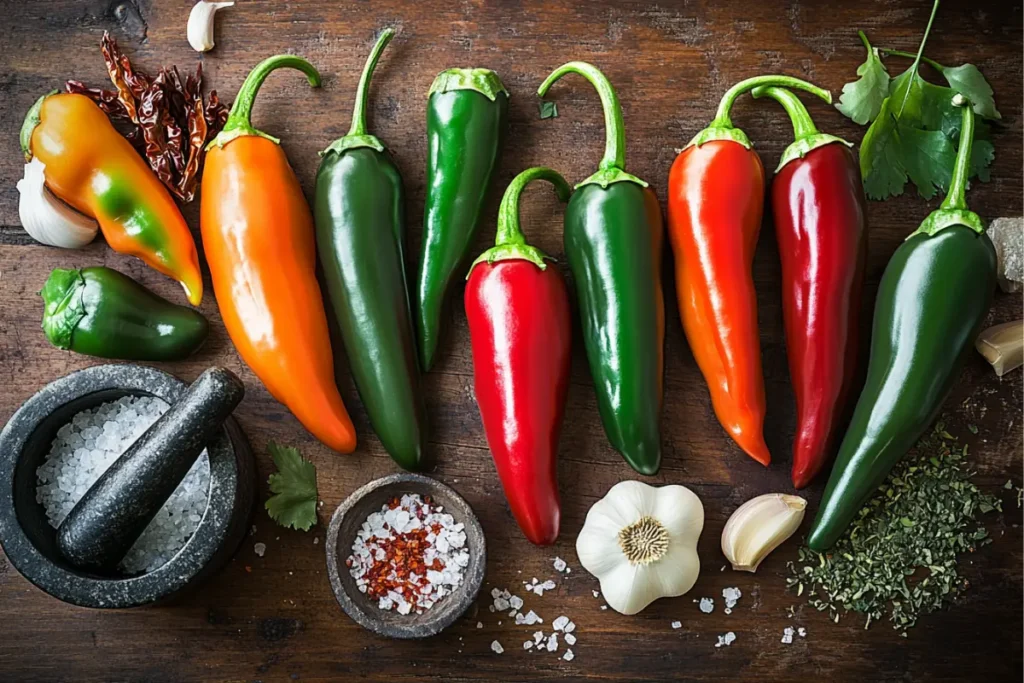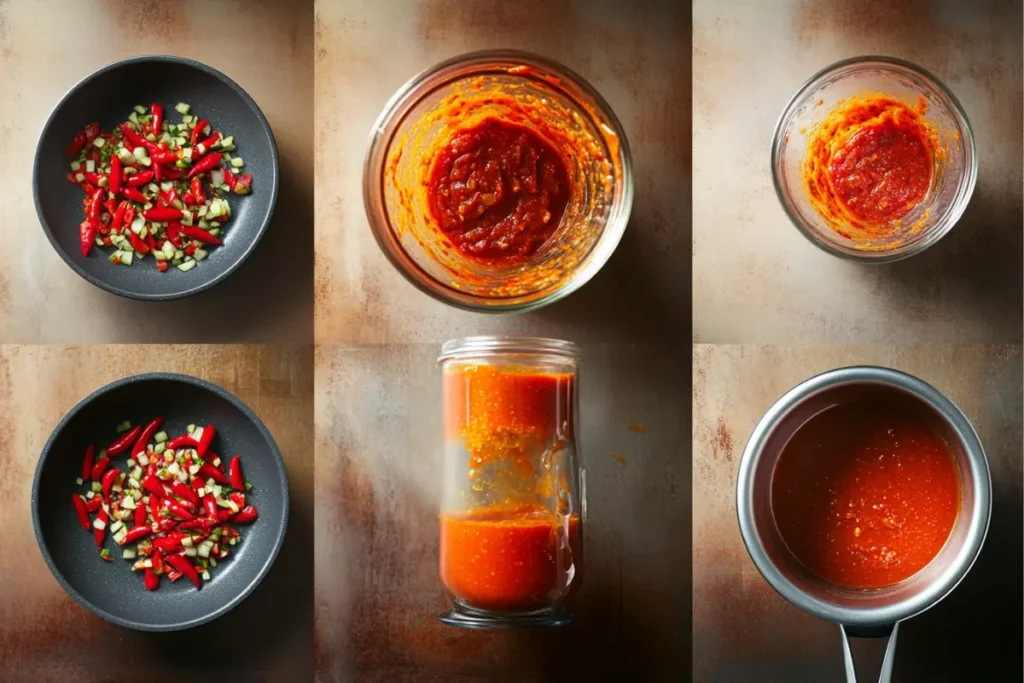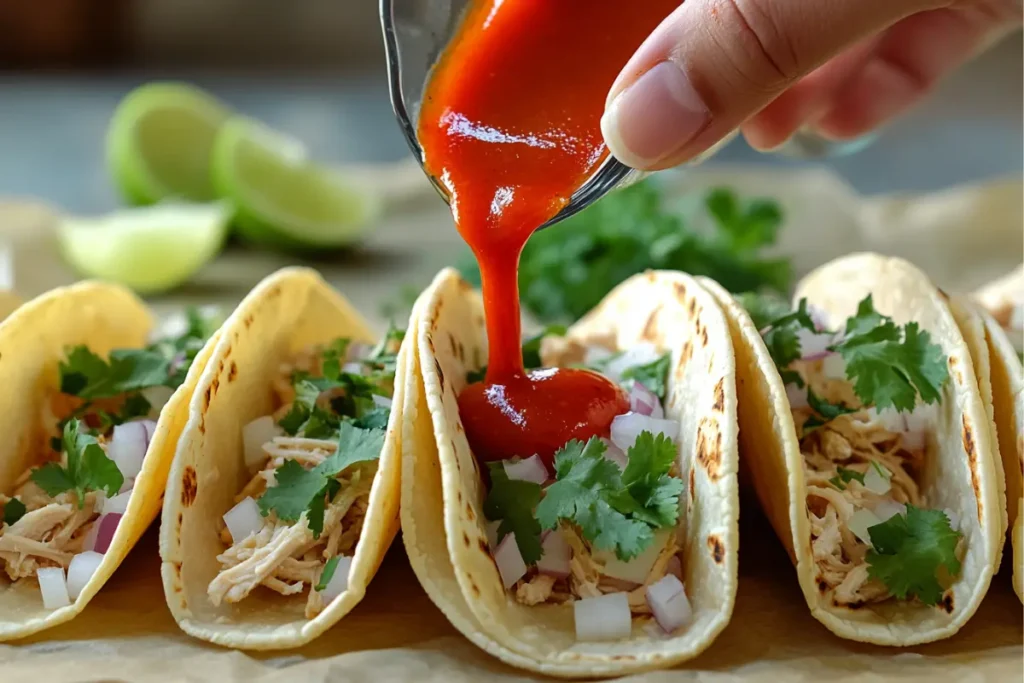Imagine adding a splash of Mexican hot sauce to your tacos. The tangy heat and bold flavors instantly make your meal more exciting. Whether it’s the smoky taste or the spicy kick, this sauce turns any dish into something special.
Hot sauce is a key part of Mexican cooking and culture. It’s loved for its variety, from mild and zesty to very spicy. Made with fresh chilies, vinegar, and spices, each type has its own unique flavor.
In this guide, we’ll explore everything about Mexican hot sauce. You’ll learn about its history, ingredients, and different types. By the end, you’ll know how to make and enjoy hot sauce like a pro. Let’s dive into this spicy journey together!
Table of Contents
A Brief History of Mexican Hot Sauce
Ancient Roots
First of all, people in Mesoamerica, like the Aztecs and Mayans, used chilies in many ways. They added them to food to enhance flavor and believed chilies had healing powers. In addition, chilies played a big role in their ceremonies and daily lives.
For example, the Aztecs crushed chilies into pastes, mixing them with water or herbs. This simple method created early forms of hot sauce. Moreover, they spiced pulque, a drink made from agave sap, with chilies to give it extra flavor for special events.
What hot drink was sacred to the Aztecs? Pulque was a sacred drink that the Aztecs enjoyed during rituals. By adding chilies, they gave it a unique, spicy twist for these occasions.
Evolution and Regional Variations
Over time, Spanish explorers introduced new ingredients, like vinegar and garlic, to Mexico. As a result, these new additions changed how hot sauces were made. This blending of ingredients created bolder and more complex flavors.
Each region in Mexico developed its own style of hot sauce. For instance, Oaxaca became known for its smoky mole-based sauces, while the Yucatán favored bright, citrusy flavors. Consequently, these regional styles reflect the creativity and diversity of Mexican cuisine.
What is the oldest known hot sauce? The oldest known hot sauces were simple chili mixtures made by the Aztecs and Mayans. These early recipes inspired the flavorful sauces we enjoy today.
The Chili Pepper Institute at NMSU has extensively researched chili peppers, from their ancient origins to modern cultivation techniques.
The Building Blocks: Ingredients of Mexican Hot Sauce

The Chili Pepper Spectrum
Chilies are the foundation of every Mexican hot sauce. They provide the heat and bold flavor that make these sauces stand out. Common chilies like jalapeños, serranos, habaneros, chipotles, and arbol chilies each bring something unique. For instance, jalapeños are mild and slightly sweet, while habaneros add intense heat and a fruity touch.
The Scoville scale measures the heat level of chilies. Jalapeños range from 2,500 to 8,000 Scoville units, making them a good choice for those who prefer mild spice. On the other hand, habaneros can reach up to 350,000 Scoville units, offering fiery heat.
Tast of home Ultimate Guide to Hot Sauces provides a deeper look at chili varieties, heat levels, and ways to use them effectively.
Dried chilies like guajillo or ancho provide a smoky flavor with lower spice levels.
What is Mexican hot sauce made of? At its simplest, Mexican hot sauce is made with chilies, vinegar, and spices. Additional ingredients like garlic, tomatoes, or onions are often included to create more complex flavors.
Flavor Enhancers
Vinegar is a key ingredient that adds tanginess and helps preserve the sauce. White vinegar brings a clean, sharp flavor, while apple cider vinegar adds a hint of sweetness. Both work well to balance the heat of the chilies.
Spices like cumin and oregano are also essential for enhancing the overall taste. For example, cumin adds warmth and depth, while oregano gives the sauce a slightly herbal flavor. These spices combine to create a balanced and flavorful base.
In addition, supporting ingredients like tomatoes, garlic, and onions make the sauce richer and more savory. Some recipes even include fruits like mango or citrus. These fruits add a touch of sweetness and brightness, making the sauce even more versatile.
Exploring the Types of Mexican Hot Sauce
Salsa Roja (Red Sauce)
Salsa Roja, or red sauce, is a cornerstone of Mexican cuisine. Cooks create this sauce using red chilies, tomatoes, garlic, and spices. For instance, guajillo or ancho chilies give it a rich red color and mild heat. Meanwhile, tomatoes add sweetness, and garlic enhances the savory flavor.
Many recipes include lime juice or vinegar to brighten the flavor and add tanginess. As a result, Salsa Roja pairs well with tacos, enchiladas, and grilled meats. Its bold taste and versatility make it a favorite in many kitchens.
What is the red sauce at Mexican restaurants? Most Mexican restaurants serve a variation of Salsa Roja. The smooth texture and balanced flavors make it a perfect topping for a variety of dishes.
Salsa Verde (Green Sauce)
Salsa Verde, or green sauce, stands out for its fresh and tangy flavor. Cooks prepare this sauce by blending tomatillos with green chilies like serranos or jalapeños. For instance, serranos add a sharper heat, while jalapeños create a milder kick.
Additionally, many recipes include garlic, onions, and cilantro to enhance the flavor. Some variations roast the tomatillos and chilies, giving the sauce a smoky twist. As a result, Salsa Verde complements tacos, enchiladas, or tortilla chips with its vibrant and zesty taste.
The Smoky Charm of Chipotle Hot Sauce
Chipotle hot sauce delivers a unique smoky flavor. Cooks use chipotle peppers, which are dried and smoked jalapeños, to create this bold sauce. These peppers bring a warm, earthy taste that enhances many dishes.
Typically, vinegar and garlic balance the smokiness, while some recipes include honey or brown sugar for sweetness. As a result, chipotle hot sauce works well with grilled meats, roasted vegetables, and even soups. Its rich flavor makes it a top choice for fans of smoky heat.
Regional Specialties
Every region in Mexico has its own take on hot sauce. For example, Oaxaca is known for mole-based sauces that combine chilies with chocolate and spices. These sauces, often served with tamales or meats, deliver a rich and earthy flavor.
The Yucatán region, on the other hand, specializes in bright, citrusy hot sauces made with habanero chilies and lime. These sauces add sharp heat and tang to seafood dishes. Meanwhile, Veracruz creates milder sauces that blend tomatoes and garlic, offering a balanced sweetness.
Altogether, these regional styles showcase the diversity and creativity of Mexican hot sauces. They reflect the ingredients and culture of their regions, offering a variety of flavors for every taste.
Craving more salsa varieties? Discover the smoky depth of Chile Morita Salsas & Stews for another taste of authentic Mexican flavor.
Creating Your Own: Homemade Mexican Hot Sauce

A Simple Starting Point: Basic Mexican Hot Sauce
Making your own Mexican hot sauce at home is easy and rewarding. Start by gathering simple ingredients like red chilies, garlic, vinegar, and salt. For example, jalapeños or serranos work well for a mild or medium heat level. Adding tomatoes or onions can enhance the flavor.
Ingredients:
- 5–6 red chilies (fresh or dried)
- 2 cloves of garlic
- ½ cup white vinegar
- 1 teaspoon salt
- 1 small tomato (optional)
Steps to Make It:
- Firstly, wash the chilies and remove the stems. If you’re using dried chilies, soak them in warm water for 10 minutes to soften them.
- Next, blend the chilies, garlic, vinegar, and salt until smooth. You can add a little water if the mixture seems too thick.
- Then, pour the mixture into a pan and simmer over medium heat for 5–7 minutes. This step helps the flavors meld together.
- Finally, let the sauce cool before transferring it to a clean glass jar for storage.
This basic hot sauce works well as a topping for any dish, from tacos to grilled vegetables. Adjust the spice level by choosing milder or spicier chilies to suit your taste.
Perfect for Tacos: Mexican Hot Sauce for Tacos

Hot sauce and tacos are a match made in heaven. A taco-specific hot sauce should complement the filling without overpowering it. For example, using tomatillos in the recipe can add a tangy kick, perfect for chicken or fish tacos.
Ingredients:
- 4 tomatillos
- 2 serrano chilies
- 1 clove of garlic
- 1 tablespoon lime juice
- ½ teaspoon cumin
Steps to Make It:
- Firstly, roast the tomatillos and serrano chilies on a hot skillet until charred.
- Next, blend the roasted ingredients with garlic, lime juice, and cumin until smooth.
- Then, simmer the sauce on low heat for 5 minutes to bring out the flavors.
- Finally, let the sauce cool before serving with your favorite tacos.
Looking for an authentic taco recipe? Check out The Best Tacos de Lengua Recipe to pair with your homemade hot sauce.
Preserving Your Creation: Canning Mexican Hot Sauce
Canning your hot sauce lets you enjoy it for months. The process is simple and ensures your sauce stays fresh and flavorful. Start by sterilizing glass jars and lids in boiling water for at least 10 minutes. This step removes bacteria and helps keep your sauce safe to eat.
Once your sauce is prepared, pour it into the sterilized jars, leaving about half an inch of space at the top. Seal the jars tightly, then place them in a water bath canner. Boil the jars for 15–20 minutes to create a vacuum seal.
After the jars cool, check the seals by pressing on the lids. If they don’t pop back, your sauce is properly sealed. Store the jars in a cool, dark place for up to six months. This method works well for both basic and taco-specific sauces, ensuring you always have a flavorful topping ready.
A Look at Popular Brands Of Mexican Hot Sauce
Mexican hot sauce is loved for its variety, with popular brands like Valentina, Cholula, and Tapatio leading the way. These sauces are known for their unique flavors and are used in many kitchens around the world.
Valentina: Valentina is famous for its bold flavor that balances spice and tanginess. Its thick texture makes it great for dipping or drizzling on snacks. What makes Valentina hot sauce so good? Many fans enjoy its ability to bring out the flavor of food without being too overpowering. It’s a favorite with chips and street food.
Cholula: Cholula has a mild level of heat and a slightly smoky taste. Its mix of spices works well with eggs, tacos, and soups. The wooden cap is a signature feature that adds to its charm.
Tapatio: Tapatio is a medium-spicy sauce with a touch of garlic flavor. It’s great for burritos, pizza, and even popcorn, making it a versatile choice for everyday meals.
Other brands like El Yucateco, known for its habanero sauces, and La Costeña, loved for its bold and authentic flavors, also stand out. With so many options, there’s a hot sauce for everyone to enjoy.
How to Use and Enjoy Mexican Hot Sauce?
Mexican hot sauce makes meals more exciting by adding heat and flavor. It goes well with tacos, burritos, and enchiladas, bringing a spicy kick to traditional foods. Drizzling it over scrambled eggs or omelets also makes breakfast more delicious.
In addition, hot sauce is perfect for snacks. For example, you can pour it over tortilla chips, grilled corn (elote), or even fresh fruit like mango or pineapple. The tangy heat works well with the sweetness of the fruit, creating a tasty contrast.
Want something refreshing to cool down the heat? Pair your spicy meals with a Classic Strawberry Horchata for a sweet and soothing balance.
FAQs About Mexican Hot Sauce
Why does Mexican hot sauce taste different?
Mexican hot sauce has a special taste because of its ingredients. It uses chilies, vinegar, and spices to create a mix of tangy, spicy, and savory flavors. Unlike other hot sauces, it balances the heat with rich flavors, making it perfect for many dishes.
Does hot sauce need to be refrigerated?
Most hot sauces don’t need the fridge if they have vinegar. Vinegar helps keep the sauce fresh and safe at room temperature. However, putting it in the fridge can help it last longer and keep its flavor, especially if it has fresh ingredients like fruits.
Why does Tabasco turn brown?
Tabasco sauce turns brown because of air exposure. When air touches the sauce, the natural ingredients react, changing its color. The sauce is still safe to eat, and the taste doesn’t change much. To slow this down, close the cap tightly and store it in a cool, dark place.
Why do I feel high after eating Mexican food?
Spicy food can make your body release endorphins, which are natural feel-good chemicals. Endorphins help reduce pain and boost happiness. This is why eating spicy Mexican food can make you feel energized and happy. It’s like a little mood boost from your food!
What do Mexicans eat when it’s hot?
On hot days, Mexicans often enjoy light meals like ceviche or fresh fruit dusted with chili powder. Cold soups, salsas, and salads (such as this Easy Mexican Chicken Salad) are also popular for their refreshing flavors.
Can you eat pizza sauce with mozzarella sticks?
Yes, pizza sauce tastes great with mozzarella sticks. The tangy tomato sauce pairs well with the creamy cheese. To make it even better, you can add a little hot sauce to the pizza sauce for a spicy kick. It’s a simple and delicious snack.
Do people put marinara sauce on pizza?
Marinara sauce can be used on pizza, but it’s not as common as pizza sauce. Marinara is thinner and has more garlic flavor. If you want to use marinara on pizza, try mixing in a little hot sauce for extra spice. It’s fun to experiment and create your favorite pizza topping!
Conclusion
Mexican hot sauce is more than just a condiment. Its unique blend of flavors, rich history, and versatility make it a must-have for any kitchen. Whether you’re drizzling it on tacos, spicing up pizza, or pairing it with fresh fruit, it adds excitement to every bite.
We hope this guide has inspired you to explore the world of Mexican hot sauce. Try new brands, experiment with homemade recipes, or share your favorite ways to enjoy it. What’s your go-to hot sauce or recipe? Let us know in the comments and join the conversation!

